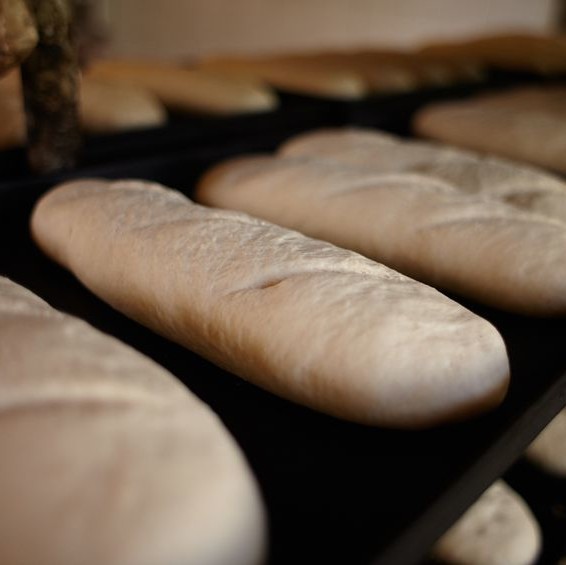
DATEM Replacement
What is a DATEM replacement?
Consumers are now more than ever seeking clean label baked products. To combat this challenge, the industry has identified and/or developed other alternatives that can completely replace DATEM in bread production while yielding similar results such as improved loaf volume, fine crumb structure, and dough extensibility. These DATEM replacements include:
- Wheat protein isolate
- Emulsifiers
- Enzymes
- Lipids
Origin
Wheat protein isolate is derived from wheat gluten by dissolving the gluten in alkaline or acidic pH solutions to isolate the protein components. Due to its effective emulsifying properties and clean label call-out, several suppliers have developed their versions of this functional ingredient.1,2
- Emulsifiers: lecithin and soy emulsifiers can also be utilized for DATEM replacement.
- Enzymes: are naturally present in wheat flour and yeast. For DATEM replacement, lipase, xylanase and phospholipase have been noted as reliable replacers.
- Lipids: can be added in the form of animal, vegetable fat or glycerides such as glycerol monostearate (GMS) – this ester is formed when glycerol is reacted with stearic acid.2
Function/Composition
The role of DATEM alternatives yield similar results including strengthening of gluten, improved extensibility of dough and loaf volume and finer crumb structure.
It has been identified that plant proteins can be an emulsifier alternative due to their flexible properties.2 More specifically, wheat protein consists of 3% globulins, 15% albumins, 33% gliadins and 49% glutenin. Wheat protein can be modified by unfolding the structure to reveal the non-polar groups to improve binding.2
Lecithin and Soy Emulsifiers: sometimes are utilized, however they are not as effective due the balance of the hydrophilic and hydrophobic groups.
Enzymes:
- 1,3-specific lipases work by hydrolysis of the polar and non-polar of lipids in flour to increase polarity to produce monoglycerides, diglycerides and free fatty acids. These compounds can then oxidize other compounds such as proteins. This improves the stability of the dough and improve volume and fine crumb structure.
- Glycerides: Glyceryl monostearate is composed of varying proportions of mono-, di-, and triglycerides of fatty acids (like stearic acid). The final product yields a finer, softer and more tender crumb and improved loaf volume.3,4,5
- Xylanase cleaves the beta-1,4- backbone of arabinoxylans and transforms hemicellulose into soluble forms to bind with the water in the dough formulation. This improves the extensibility of the dough, increases loaf volume and produces a finer crumb structure.6
Lipids: work whereby the lipid crystals are absorbed into the gas cell structure. This stabilizes the expanding gas cells and promotes the retention of gas to produce a fine crumb structure in the final product.7
Nutrition
Among improving the protein content, certain wheat protein isolates have the ability to decrease the amount of carbohydrates when utilized in a baked product.2 Because enzymes denature during baking, they do not appear on the final product ingredient label. This can be considered clean baking to the consumer.6
Application
DATEM replacements can not only be utilized in bread formulations, but can also be applied in almost any baked good system to strengthen the gluten network in addition to improving the crumb structure and the volume of the final product.
There have been studies that examine the complete replacement of DATEM with wheat protein isolate. In one study following the AACC Method 10-10.03 for the production of bread, when DATEM was completely replaced with a wheat protein isolate, the loaf volume and crumb quality scores were similar and no significant differences were observed. Additionally, the dough strength, elasticity and extensibility were improved and the mix time was reduced.
The use of lipase in any bread formulation can yield a finer crumb structure as well as slow the staling process.
DATEM replacers can also be utilized in gluten-free bread formulations to improve the lack of gluten structure and produce products with improved loaf volume and crumb structure.9 It can also be utilized in formulations that utilize other grains to improve the process and end product.6
Besides bread, glycerides have been utilized to produce Madeira cakes with improved volume and crumb structure.3
References
- “What? A Non-Enzyme Based DATEM Replacement? | Blog.” Bakerpedia, 2 Apr. 2018, bakerpedia.com/non-enzyme-based-datem-replacement/.
- Patil, Sakharam K. “Wheat Protein Isolates – Alternative to Sodium Caseinate.” Cereal Foods World, vol. 51, no. 5, Sept. 2006, pp. 279–281., doi:10.1094/cfw-51-0279.
- Coppock, J. B. M., M. A. Cookson, D. H. Laney, and D. W. E. Axford. “The role of glycerides in baking.” Journal of the Science of Food and Agriculture 5.1 (1954): 8-26.
- Cauvain, Stanley P., et al. Using Cereal Science and Technology for the Benefit of Consumers: Proceedings of the 12th International ICC Cereal and Bread Congress 23-26 May, 2004, Harrogate, UK. CRC Press, 2008.
- Delcour, Jan A., and R. Carl. Hoseney. Principles of Cereal Science and Technology. AACC International, 2010.
- Schoenlechner, Regine, Marta Szatmari, Attila Bagdi, and Sandor Tömösközi. “Optimisation of bread quality produced from wheat and proso millet ( Panicum miliaceum L .) by adding emulsifiers, transglutaminase and xylanase.” LWT – Food Science and Technology 51.1 (2013): 361-366.
- Pareyt, Bram, Sean M. Finnie, Joke A. Putseys, and Jan A. Delcour. “Lipids in bread making: Sources, interactions, and impact on bread quality.” Journal of Cereal Science 54.3 (2011): 266-279.
- Schaffarczyk, Monika, Henrik Østdal, Olivia Matheis, and Peter Koehler. “Relationships between lipase-treated wheat lipid classes and their functional effects in wheat breadmaking.” Journal of Cereal Science 68 (2016): 100-107.
- Pareyt, Bram, et al. “Lipids in Bread Making: Sources, Interactions, and Impact on Bread Quality.” Journal of Cereal Science, vol. 54, no. 3, 2011, pp. 266–279., doi:10.1016/j.jcs.2011.08.011.
- Abdullah S. Colakoglu, Hazım Özkaya. “Potential use of exogenous lipases for DATEM replacement to modify the rheological and thermal properties of wheat flour dough.” Journal of Cereal Science, Volume 55, Issue 3, 2012. ISSN 0733-5210. https://www.sciencedirect.com/science/article/pii/S0733521012000422

